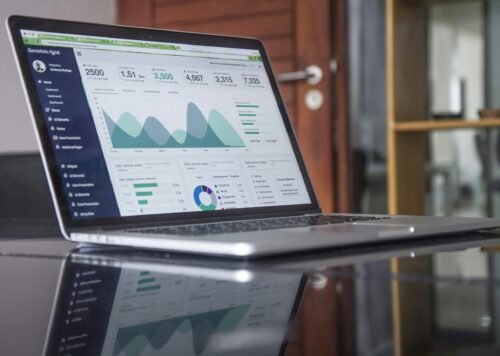Sales forecasting is a critical tool for businesses seeking to optimize their performance and make informed decisions. However, navigating through the multitude of systems available in today’s market can be overwhelming. In this article, we will explore the top contenders in the realm of sales forecasting systems, providing you with valuable insight into their key features and benefits. By understanding which system can best support your sales forecasting needs, you can effectively elevate your organization’s forecasting capabilities and drive success in the competitive business landscape.

Introduction
In today’s dynamic business landscape, accurate sales forecasting is essential for organizations to effectively plan and manage their operations. Sales forecasting provides crucial insights into future revenue, enabling businesses to make informed decisions regarding resource allocation, inventory management, production planning, and overall strategy. To achieve accurate sales forecasting, businesses rely on various systems and tools, each offering unique capabilities and features. This article will explore the different systems and tools that support sales forecasting, their roles, and key features.
CRM Systems
Overview of CRM Systems
Customer Relationship Management (CRM) systems are designed to track and manage customer interactions, providing businesses with a comprehensive view of their customers. CRM systems store customer data, including contact information, purchase history, preferences, and communication logs. This data is invaluable for sales forecasting as it helps identify patterns and trends in customer behavior.
Role in Sales Forecasting
CRM systems play a pivotal role in sales forecasting by providing valuable customer insights. By analyzing past customer interactions, CRM systems help identify repeat customers, predict customer behavior, and estimate future sales volumes. Sales teams can leverage CRM systems to prioritize leads, track sales pipelines, and forecast the probability of closing deals. Additionally, CRM systems enable sales managers to monitor sales performance, identify bottlenecks, and allocate resources effectively.
Key Features
Key features of CRM systems supporting sales forecasting include contact management, lead tracking, opportunity management, sales reporting and analytics, and integration with other business systems such as ERP. Contact management allows the storage and organization of customer information, facilitating accurate sales forecasting. Lead tracking capabilities enable sales teams to monitor the progress of potential customers, enabling more accurate predictions of future sales. Opportunity management provides insights into potential sales deals, their values, and the probability of closure. Sales reporting and analytics tools help analyze sales data, identify trends, and generate forecasts. Integration with ERP systems ensures seamless data flow between sales and other business functions, enhancing forecasting accuracy.
ERP Systems
Overview of ERP Systems
Enterprise Resource Planning (ERP) systems integrate various business functions such as finance, supply chain, manufacturing, and human resources into a single cohesive system. ERP systems provide a centralized platform for managing core business processes and facilitate the sharing of data across departments.
Role in Sales Forecasting
ERP systems have a significant role in sales forecasting by consolidating data from multiple business functions. By integrating sales data with other key business metrics, such as inventory levels, production schedules, and financial information, ERP systems provide a holistic view of the organization’s operations. This comprehensive view enables accurate sales forecasting by considering various factors that impact demand and supply.
Key Features
Key features of ERP systems supporting sales forecasting include sales order management, inventory management, production planning, financial integration, and reporting capabilities. Sales order management tracks customer orders, ensuring accuracy and timeliness. Integrated inventory management provides insights into stock levels, enabling accurate forecasting of product availability. Production planning modules help align production schedules with forecasted demand, ensuring optimal resource utilization. Financial integration ensures that sales forecasts consider the financial implications and constraints of the organization. Reporting capabilities provide real-time visibility into sales performance, enabling continuous monitoring and adjustment of forecasts.
Business Intelligence Tools
Overview of Business Intelligence Tools
Business Intelligence (BI) tools are software applications that gather, analyze, and present data to support decision-making processes. BI tools consolidate data from various sources, transforming it into meaningful insights through reports, dashboards, and data visualizations.
Role in Sales Forecasting
Business Intelligence tools play a vital role in sales forecasting by providing advanced analytics capabilities. These tools enable businesses to analyze historical sales data, identify patterns, and forecast future sales trends. By leveraging data visualization and predictive modeling techniques, BI tools enhance forecasting accuracy and enable users to make data-driven decisions.
Key Features
Key features of Business Intelligence tools supporting sales forecasting include data integration, advanced analytics, data visualization, and collaboration capabilities. Data integration capabilities allow BI tools to consolidate data from various sources, such as CRM systems, ERP systems, and external databases, ensuring comprehensive forecasting. Advanced analytics functionalities, such as regression analysis and time series forecasting, enable accurate predictions based on historical data. Data visualization tools present data in a visually appealing and intuitive manner, facilitating better understanding and insights. Collaboration capabilities promote cross-functional collaboration, allowing stakeholders to contribute to the forecasting process.

Demand Planning Systems
Overview of Demand Planning Systems
Demand Planning systems are specialized software applications designed to forecast customer demand and optimize inventory levels accordingly. These systems leverage historical sales data, market trends, and various algorithms to generate accurate demand forecasts.
Role in Sales Forecasting
Demand Planning systems have a critical role in sales forecasting by focusing on understanding and predicting customer demand. These systems consider various factors such as seasonality, promotions, market trends, and external factors that influence demand. By analyzing historical data and applying forecasting models, demand planning systems provide accurate sales forecasts that help organizations optimize inventory levels, reduce stockouts, and avoid excess inventory.
Key Features
Key features of Demand Planning systems supporting sales forecasting include demand modeling, statistical forecasting, inventory optimization, and supply chain integration. Demand modeling capabilities allow organizations to develop mathematical models that capture unique demand patterns and factors. Statistical forecasting techniques, such as moving averages and exponential smoothing, enable accurate predictions based on historical data. Inventory optimization tools help determine optimal stock levels based on forecasted demand, minimizing costs associated with carrying excess inventory or stockouts. Integration with supply chain systems ensures that forecasted demands align with procurement and production plans.
Excel and Spreadsheet Tools
Overview of Excel and Spreadsheet Tools
Excel and other spreadsheet tools are widely used for data analysis and forecasting due to their flexibility and familiarity. These tools provide functionalities for manipulating, analyzing, and visualizing data, making them accessible to a wide range of users.
Role in Sales Forecasting
Excel and spreadsheet tools serve as fundamental tools for sales forecasting, especially for small businesses or individuals. These tools enable users to organize and analyze sales data, apply basic forecasting models, and generate forecasts using formulas and functions. With the right knowledge and skills, users can leverage these tools to estimate future sales and identify trends or patterns.
Key Features
Key features of Excel and spreadsheet tools supporting sales forecasting include data manipulation, basic forecasting functions, customizable templates, and data visualization capabilities. Data manipulation functionalities, such as sorting, filtering, and pivot tables, enable users to organize and analyze sales data effectively. Basic forecasting functions, such as moving averages and linear regressions, allow users to generate simple forecasts based on historical data. Customizable templates provide pre-built models and formulas for common forecasting scenarios, simplifying the forecasting process. Data visualization capabilities, such as charts and graphs, help summarize and present forecasted data in a visually appealing format.

Statistical Forecasting Tools
Overview of Statistical Forecasting Tools
Statistical forecasting tools are specialized software applications that utilize advanced statistical techniques to generate accurate forecasts. These tools offer a wide range of forecasting algorithms and models to cater to different types of sales data and business scenarios.
Role in Sales Forecasting
Statistical forecasting tools play a crucial role in sales forecasting by offering more sophisticated and accurate forecasting methodologies. These tools can handle large datasets, identify complex patterns, and generate forecasts considering various factors such as seasonality, trends, and outliers. By incorporating advanced statistical techniques, such as ARIMA (Autoregressive Integrated Moving Average) and exponential smoothing, statistical forecasting tools provide reliable forecasts that improve decision-making processes.
Key Features
Key features of statistical forecasting tools supporting sales forecasting include advanced algorithms, time series analysis, predictive modeling, and forecast accuracy measures. These tools offer a wide range of advanced algorithms, such as ARIMA, to handle different types of sales data and business scenarios. Time series analysis capabilities help identify patterns, trends, and seasonality in sales data, improving the accuracy of forecasts. Predictive modeling techniques enable the incorporation of additional variables, such as marketing campaigns or economic indicators, into the forecasting process. Forecast accuracy measures allow users to evaluate and compare the performance of different forecasting models, ensuring continuous improvement.
Forecasting Software
Overview of Forecasting Software
Forecasting software is specialized software designed to automate and streamline the sales forecasting process. These solutions integrate data from various sources, apply advanced forecasting techniques, and generate accurate forecasts in a user-friendly interface.
Role in Sales Forecasting
Forecasting software plays a significant role in sales forecasting by providing a holistic and automated solution. These tools simplify data collection, aggregation, and analysis, eliminating manual efforts and increasing efficiency. By utilizing advanced forecasting algorithms and incorporating various data sources, forecasting software enables accurate and timely forecasting. The user-friendly interface enhances collaboration, provides real-time visibility, and facilitates the generation of actionable insights.
Key Features
Key features of forecasting software supporting sales forecasting include data integration, automated forecasting, scenario analysis, collaboration capabilities, and reporting functionalities. Data integration capabilities allow the software to gather and consolidate data from various sources, ensuring comprehensive forecasting. Automated forecasting functionalities streamline the forecasting process, reducing manual efforts and increasing efficiency. Scenario analysis capabilities enable users to evaluate the impact of different scenarios on sales forecasts, enhancing decision-making processes. Collaboration capabilities facilitate cross-functional collaboration, allowing various stakeholders to contribute to the forecasting process. Reporting functionalities provide real-time visibility into sales forecasts, enabling continuous monitoring and adjustment.
Machine Learning and AI
Overview of Machine Learning and AI
Machine Learning and Artificial Intelligence (AI) are emerging technologies that leverage algorithms and computational power to analyze large datasets, identify patterns, and make predictions. These technologies have revolutionized many industries, including sales forecasting.
Role in Sales Forecasting
Machine Learning and AI have a significant role in sales forecasting by offering advanced analytics capabilities and improving forecast accuracy. These technologies can handle complex and non-linear relationships between variables, uncover hidden patterns, and adapt to changing market dynamics. By continuously learning from data and adjusting models, Machine Learning and AI enable organizations to generate accurate forecasts that incorporate various internal and external factors.
Key Features
Key features of Machine Learning and AI supporting sales forecasting include advanced algorithms, pattern recognition, real-time analysis, and adaptability. These technologies offer a wide range of advanced algorithms, such as neural networks and decision trees, that can capture complex relationships in sales data. Pattern recognition capabilities enable the identification of hidden patterns and trends, enhancing forecast accuracy. Real-time analysis allows organizations to incorporate real-time data, such as web traffic or social media sentiment, into the forecasting process for timely and accurate predictions. The adaptability of Machine Learning and AI models ensures that forecasts can adjust to changing market dynamics, providing accurate predictions even in volatile environments.
Conclusion
Accurate sales forecasting is essential for organizations to plan and manage their operations effectively. By leveraging various systems and tools, businesses can generate accurate sales forecasts that consider customer behavior, market trends, and internal factors. CRM systems provide valuable customer insights, ERP systems integrate key business metrics, Business Intelligence tools offer advanced analytics capabilities, Demand Planning systems focus on understanding customer demand, Excel and spreadsheet tools provide flexibility and familiarity, statistical forecasting tools utilize advanced statistical techniques, forecasting software streamlines the process, and Machine Learning and AI technologies improve forecast accuracy. By adopting the right systems and tools, organizations can enhance their sales forecasting capabilities and make data-driven decisions that drive growth and success.
